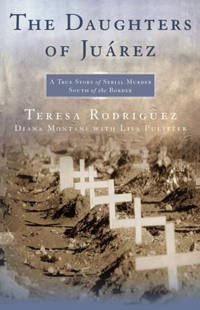 |
 |
 |
 Entertainment | Books | May 2007 Entertainment | Books | May 2007  
Bodies Pile Up in Mexico
 Ceci Connolly - The Washington Post Ceci Connolly - The Washington Post


| The Daughters of Juarez: A True Story of Serial Murder South of the Border
by Teresa Rodriguez and Diana Montane with Lisa Pulitzer
Atria - 316 pages - $23.95.
Check it out at Amazon.com |
The first body was found Jan. 23, 1993. Alma Chavira Farel had been raped, beaten and strangled, then dumped in a lot on the outskirts of Ciudad Juarez. Five months later another victim turned up, her body too mangled to be identified. By year's end, the tally hit 16 - all dark-haired young women, mutilated and ditched in the barren desert across the Rio Grande from El Paso. About 400 bodies appeared over 13 years. And still the slaughter continues.

Two Hollywood movies have fictionalized the story, and now, finally, the scandal is getting the serious treatment it deserves in what is being touted as the first nonfiction account in English of the unsolved murders.

Teresa Rodriguez, a Univision reporter, with assists from co-authors Diana Montane and Lisa Pulitzer, describes an industrial border city in which indifference, incompetence and sexism enabled a serial killer - or more likely several - to operate unchecked for more than a decade. She introduces a Mexican culture in which men dominate, the rule of law means little, women are devalued, corruption runs rampant and some people actually blame the victims.

At times, Rodriguez is overly reliant on cliches - corpses "pile up like cordwood," and "the names and the faces have changed, but the stories are sadly the same."

But when Rodriguez focuses on the women and their stories, the book is compelling and valuable. Contrary to widespread perceptions, few of the victims were prostitutes. Many worked 12-hour shifts in the U.S.-owned maquiladoras, traveling to and from the factories before sunrise or after midnight, often on foot.

Throughout The Daughters of Juarez, suspects are locked up based on circumstantial evidence or coerced confessions. Bodies are misidentified, a lawyer is killed gangland style, and experts from Amnesty International detail egregious investigative errors.

Even after authorities had arrested Abdel Latif Sharif Sharif in connection with the killings, bodies continued to appear; police claimed the Egyptian was directing members of Los Rebeldes gang to keep killing local girls from his cell.

Most troubling, though, is the lack of answers. As recently as November, one victim's mother expressed doubts about the guilt of two men charged in her daughter's death. "We don't want scapegoats. We don't want torture. . . or lies," she said. "What I want is the truth." | 
 | |
 |



